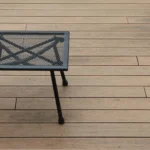Composite decking has surged in popularity over the past decade, offering homeowners a modern alternative to traditional wood for their outdoor living spaces. Known for its durability, low maintenance, and resistance to rot and pests, it’s often seen as the ideal solution for long-lasting decks. But while composite decking brings many benefits, it’s not without its drawbacks.
Before you commit to this investment, it’s essential to understand the disadvantages of composite decking so you can make an informed decision based on your project, budget, and personal preferences.
1. Higher Initial Cost
One of the most frequently cited drawbacks of composite decking is its higher upfront cost compared to natural wood. While traditional pressure-treated lumber might cost less per square foot, composite boards often come with a steeper price tag due to the materials and manufacturing involved.

The composite decking is made of wood fiber, recycled plastic and some additives. Now the most popular type of composite decking is the co-extruded composite decking, which has better cap protection, higher durability and longer longevity. And the price is also higher,
Although composite decking can save money over time through reduced maintenance, the initial cost might not be feasible for all homeowners, especially those managing tight budgets or large-scale projects.
2. Heat Retention in Direct Sunlight
Composite decking tends to retain heat, especially darker-colored boards and in areas exposed to direct sunlight. This can make the surface hot and uncomfortable to walk on barefoot during summer months.
In contrast, natural wood typically stays cooler due to its organic composition. If your deck gets full sun exposure, this can be a critical factor—especially around pools or children’s play areas. Choosing lighter-colored composite boards or incorporating shade structures like pergolas can help mitigate this issue.

3. Can Be Slippery When Wet
While composite materials are generally more slip-resistant than polished wood or tile, some composite decking can become slippery when wet, particularly cheaper products or older generations of boards without enhanced surface textures.
This can be a concern for decks near pools, hot tubs, or areas that receive frequent rain. Newer products have improved traction, but if safety is a top priority, especially for children or seniors, make sure to look for boards specifically rated for slip resistance. Here is a guide that can help you avoid slippery deck and find proper slip-resistant composite decking: Is Your WPC Deck Too Slippery? How to Improve Traction and Safety

4. Fading and Color Inconsistency Over Time
Exposure to UV rays can lead to fading and discoloration in composite decking. While higher-end brands include UV inhibitors to minimize this effect, even the best composite boards may experience some level of color change over time.
Another issue is color inconsistency between different product batches. If you ever need to replace a few boards or expand your deck later, it might be hard to find a perfect color match. Planning ahead and buying extra boards from the same batch can help avoid this problem.
5. Susceptibility to Mold and Mildew
Though composite decking is moisture-resistant, it’s not completely immune to mold and mildew, especially in shaded or damp environments. The wood fibers within the boards can absorb moisture if the surface layer is damaged or not well-ventilated, allowing mold to develop over time.
Regular cleaning and ensuring proper airflow underneath your deck are essential to prevent these growths and maintain the material’s appearance and integrity.
6. Not Completely Natural-Looking
Many homeowners love the look and feel of real wood, and this is where composite decking might fall short. Despite significant improvements in grain patterns and coloring, composite materials still don’t perfectly replicate the authenticity of natural wood.
If you’re someone who values the rustic charm, smell, or tactile sensation of real timber, composite may not fully meet your expectations.
7. Limited Repair Options
Composite boards are tough—but they’re not immune to damage. If a board gets scratched, dented, or chipped, repairs can be difficult. Unlike wood, which can be sanded and refinished, composite boards can’t be restored the same way.
In many cases, the only option is to replace the damaged board entirely, which might be challenging if you don’t have a matching replacement on hand.

8. Environmental Concerns
Although composite decking is often marketed as eco-friendly due to the use of recycled materials, not all products are created equal. Some brands still use virgin plastics, and the boards themselves are not always recyclable at the end of their life cycle.
This means composite decking may eventually end up in a landfill, unlike wood, which can biodegrade or be repurposed more easily. To address this, look for manufacturers that prioritize sustainability, such as those using recycled content and offering end-of-life recycling programs.
Be Aware of the Disadvantages of Composite Decking
While composite decking brings significant advantages in terms of convenience and long-term performance, it’s essential to be aware of the disadvantages of composite decking before making a decision. From higher initial costs and heat retention to aesthetic limitations and repair challenges, composite decking isn’t the perfect fit for every home or homeowner.
By weighing these potential drawbacks alongside the benefits, you’ll be better prepared to decide if composite decking is right for your needs, lifestyle, and budget. If you want to know more about composite decking, you can also read this full guide: Everything You Need to Know About Composite Decking
Want to get more insights on composite decking and eco-friendly home upgrades? visit ecobuildhome.com, where you can find useful maintenance tips, installation guides and buying guides for wood composite and sustainable materials.

